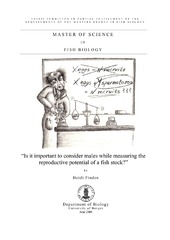“Is it important to consider males while measuring the reproductive potential of a fish stock?”
Abstract
This study explored the paternal contribution to stock reproductive potential in Northeast Arctic (NEA) cod (Gadus morhua L.). An equation for estimating total annual viable sperm production (VSP) was parameterised for NEA cod based on new and historical data obtained at the Lofoten spawning grounds. A principal component analysis indicated that there were no obvious changes in the relationships between the variable male traits each year which supported the use of a single equation for fitting the historical data. VSP was estimated in the time period the stock has been assessed (1946-2005). The parameterised equation resulted in approximately tenfold higher VSP than the original equation, but followed the same temporal changes. The VSP from the parameterised equation was used to predict recruitment in a Beverton-Holt model, but resulted in similar recruitment predictions as the traditional spawning stock biomass or total egg productions methods. Male characteristics were evaluated as possible important traits affecting the reproductive potential, including condition, GSI, drumming muscles mass, sperm motility and sperm density. Sperm density was positively correlated with GSI in 2007, but negatively correlated to fish length. No correlations were found in 2008 between sperm density and any of the evaluated male traits. Sperm motility correlated positively to gonad weight, GSI and drumming muscle mass in 2008. Some of these results may indicate that sperm quality is related to fish size. Indications of sperm quality related to fish size may affect the reproductive potential in exploited fish stocks where size selective harvesting can cause a lower mean fish size and potentially a lower sperm quality. More detailed experiments, including direct assessment of fertilisation success in NEA cod, may improve the parameterised equation which might narrow the gap of knowledge of reproductive processes at the population level.
Publisher
The University of BergenCopyright
The authorCopyright the author. All rights reserved
